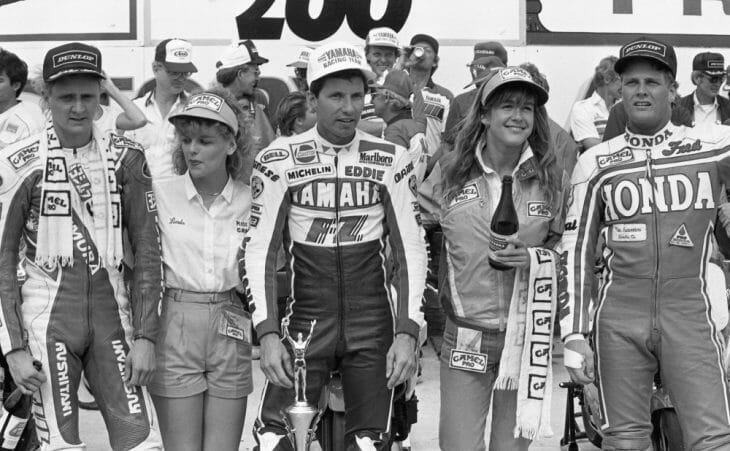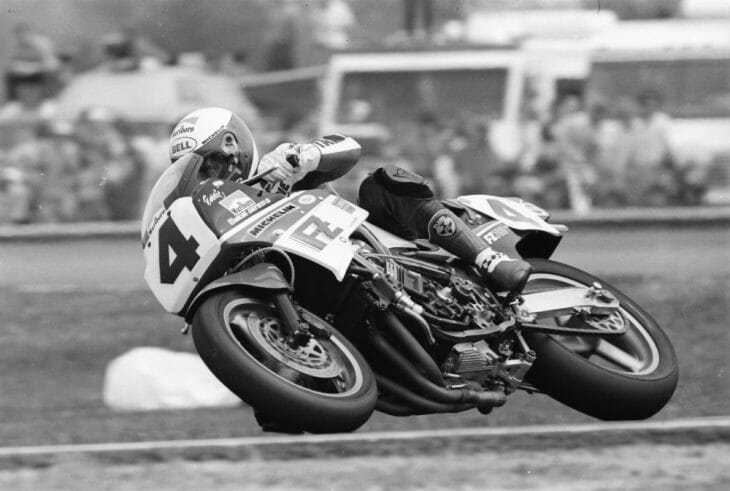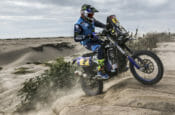
The mere fact that Eddie Lawson was even entered in the 1986 Daytona 200 was a minor miracle. Going into that season he was focusing on winning back the 500cc Grand Prix World Championship he’d lost to rival Freddie Spencer in 1985.
One might expect Yamaha to want Lawson to avoid the potential risk of Daytona, but the sportbike market was starting to heat up. Yamaha had introduced its excellent FZ750 the year before. They threw numbers at the ’85 Daytona 200, hiring a bunch of riders to race the bike, but it was too early. The FZ as a Superbike lacked development and it was a Honda clean sweep of the podium. The highest finishing Yamaha in the ’85 Daytona 200 was Canadian Rueben McMurter, who finished fifth.
Suzuki was stepping up the stakes even higher in ’86 with the American introduction of the GSX-R750 – and they had a young gun named Kevin Schwantz. The young Texan was already showing tremendous potential in ‘85, scoring three AMA Superbike victories in limited outings on the outdated Suzuki 750ES. Yamaha recognized that its window of opportunity to win Americas biggest road race with the FZ might be narrowing.
“Yamaha in America wanted it pretty badly, so I decided I would do it,” Lawson told Cycle News in an interview a few weeks before Daytona. “I told them I would only do it if the equipment was capable of running in the front. They seem to think it is and after testing it, it seems good.”
Lawson went on to say he was impressed by the handling of the ’86 factory Yamaha FZ750 Superbike, but had been away from Superbike racing long enough that he was at a loss in terms of trying to assess the bike’s power. “After getting off the 500 (Yamaha GP bike) everything seems slow,” he added.
The loss of his world title served to snap Lawson into hyper-focus. His off-season regiment was the toughest he’d ever put himself through and the results showed. Lawson was lean, cut and mentally tough when he showed up to Daytona. His concentration level was astonishing. In those days rarely did an entire Bike Week go flawlessly for any rider, but that wasn’t the case with Lawson. Everything went to plan from the first practice session.
He not only won the pole with a track record, Lawson also took an easy victory in his Heat race, the faster of the two, with Rainey winning the other.
Daytona ’86 was expected to be a showdown with defending race winner Freddie Spencer, but Spencer never showed up. Honda said that Spencer had been ill with a sinus infection and had lost 15 lbs. Spencer’s absence certainly disappointed fans and perhaps opened the door a little wider for Lawson, but there was no shortage of competition for the 1984 World Champ.
Honda was loaded again with newly hired Wayne Rainey, defending AMA Superbike Champion Fred Merkel and emerging flat track superstar, turned road racer Bubba Shobert. Yoshimura Suzuki had a true weapon in its new GSX-R750 and Schwantz was loaded with talent and looked prepared to upset the Honda vs Yamaha storyline. Backing up Schwantz was the newly-crowned Japanese Superbike (TT-F1) Champion Satoshi Tsujimoto. Taking no chances, Yamaha also brought GP racer Mike Baldwin to the proceedings, along with Jimmy Filice.
Lawson edged Rainey in qualifying. Schwantz, Tsujimoto and Baldwin rounded out the front-row starters. Lawson found out that the one open question about the power of the Yamaha, was answered with resounding positives. Not only was he the fastest qualifier, but trap speeds showed his machine was the second fastest bike, topping out at 170.13 mph. Only Rainey’s Honda was slightly faster on the top end at 171.42 mph. Schwantz’ Suzuki came in at 169.17 mph.
There was a massive 160 rider entry list in that year’s 200, which meant that half of the riders never made it to the starting grid.
The 200 quickly developed into a battle between Lawson, Rainey and Schwantz. The trio quickly gapped the rest of the field.
Lawson looked effortless in setting the pace, leading most of the time. Rainey’s Honda was fast, slipping past Lawson here and there, but mainly he seemed happy to latch on to Lawson and use him as a gauge. Schwantz was hanging in there, but looked on the ragged edge doing it, finding he was forced to try to brake later and lean his Suzuki harder to stay with the leaders. Schwantz eventually realized he was going to have to dial it back if he was going to go the distance, so six or seven laps in he dropped off the pace, just a tad, making it a two-way fight for the lead.
The pace was so intense that Lawson and Rainey were hitting lapped traffic by the seventh lap!

The grunt of V-4 Honda VFR750 was allowing Rainey to hook up wonderfully out of the corners, but at a cost. He slowed and then pulled in on the 15th lap with a chunked tire. The crew was not ready for the premature stop and he lost 50 seconds in the pits.
Lawson by now was long gone.
Lawson built on his lead the rest of the way in a flawless race, complete with ultra-fast sub-20-second pit stops. He was so much in control, that after his last pit stop he dialed back his pace by 2 seconds per lap and still went unchallenged. Schwantz was the only real threat, until the chain stretched on his Suzuki wearing down the sprocket teeth. He would have to nurse the bike the rest of the race. Merkel was gaining on Schwantz and likely would have passed him for second, but he too chucked a tire on his Honda late, ending his hopes of a runner-up finish.
Lawson was happy with his victory and his $20,000 payday. There wasn’t a lot to talk about after such a dominating win.
“I thought if he was going to run the whole distance that way, we were in for a hell of a race,” Lawson said of Rainey. “It was just a matter of getting through traffic and it was bad. My tires were getting a little slippery at the end, but it wasn’t like they were unrideable.”
Lawson’s race time of one hour, 54 minutes, 49.656 seconds at an average of 106.030 mph, shattered the record for the Daytona 200 set the year before by Spencer by over three minutes with Spencer ’85 victory completed in 1 hour, 58 mins, 13.067 secs. at 102.989 mph.
It also marked Yamaha’s first ever AMA Superbike victory.
Lawson would go on to wrap up a fantastic 1986, but winning back the 500cc Grand Prix World Championship.
